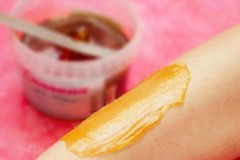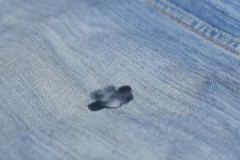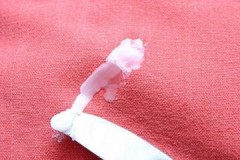Proven Ways To Remove Wax From Clothes And Fabrics
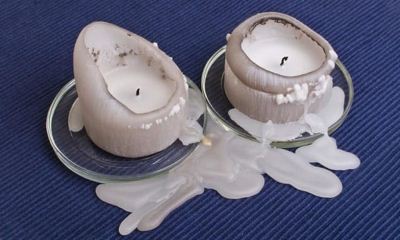 Wax from a candle or used in cosmetology for depilation, when it gets on the fabric, can ruin both the thing and the mood.
Wax from a candle or used in cosmetology for depilation, when it gets on the fabric, can ruin both the thing and the mood.
Homemade recipes and special remedies will help to cope with a difficult situation.
How and how to remove drops of wax for depilation or paraffin from a candle from clothes at home, we will tell in the article.
Content
What is the danger of wax stains?
Wax marks are difficult stains. The difficulty in removing such stains is due to the composition.
An added complication is the fact that the wax gets on the fabric in a hot, melted state. It very quickly penetrates the fibers and hardens, sticking them together.
You can clean off such a drop with a mild knife, spatula or other suitable object.... But on the material itself, a bold noticeable mark will remain, which is already much more difficult to remove.
Another danger of candle droplets is the dyes used. Candles, unusual in shade, are made using persistent color pigments. In this case, spilled wax can leave behind not only a greasy mark, but also stain the fabric.
How to remove with improvised means at home?
Regular laundry detergents won't help remove stains... Other techniques will be needed to remove the wax mark. All of them are not complicated. But they require accuracy when carrying out manipulations.
Warming up with an iron
This method can be recommended for dense materials. First, remove the convex part of the wax drop from the surface of the fabric by scraping with a spatula or scraper.
For further work you will need:
- a pair of cotton napkins;
- White paper;
- iron.
The order of work:
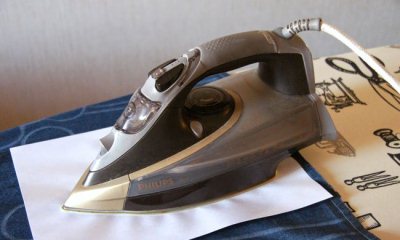 Heat the iron. The heating temperature should be no more than the maximum indicated on the label for the thing being processed.
Heat the iron. The heating temperature should be no more than the maximum indicated on the label for the thing being processed.- Switch off the steam supply.
- Place one of the prepared cloths on the ironing board.
- Place the injured item on top so that the stain is on top.
- Cover the stained area with white paper.
- Start ironing with an iron.
- After the heated wax has soaked the paper, it is removed and a new one is used.
- Repeat the treatment until greasy spots show through on the paper.
Remains of a trace on the material can be modified with a stain remover.
Remove with turpentine
If the option with heating the spot for some reason cannot be realized, you can use turpentine.
The order of work in this case:
- soak a cotton swab with turpentine;
- gently treat the affected tissue area with blotting movements;
- after the trace has disappeared, wash the thing in the usual way at the maximum allowable temperature;
- rinse.
Freezing
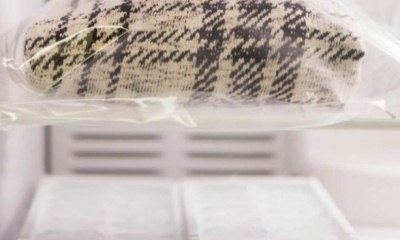 It is very difficult to remove wax from complex, textured surfaces of fabrics. Most of the recipes in this case are not applicable, since they can aggravate the situation - increase the stain.
It is very difficult to remove wax from complex, textured surfaces of fabrics. Most of the recipes in this case are not applicable, since they can aggravate the situation - increase the stain.
To achieve the effect, the item can be frozen, which will lead to the fragility of the paraffin or wax stain. In winter, you can simply take the thing out into the cold. But this method is only suitable for winter.
At other times, soiled clothing must be folded so that the stain is on top and placed in a plastic bag in the freezer. As soon as the wax freezes and becomes brittle, you need to break it with your hands and brush off all the pieces with a brush.
Dishwashing liquid
For fabrics that cannot be heated or frozen, a dishwashing detergent method can be used.
Order of use:
- Apply a small amount of undiluted dishwashing liquid to the affected area.
- Rub lightly.
- Leave the garment to lie down for 10 hours.
- Wash a thing.
If washing by hand, pay special attention to the stained area.
How to withdraw with special formulations?
In addition to the improvised means that can be found on the farm, you can use effective preparations specifically designed to eliminate this kind of pollution.
Dr. Beckmann stain remover
Special product suitable for removing greasy residueleft after removing the wax. The preparation contains surfactants that can cope even with complex contaminants (up to 15% of nonionic surfactants and anionic surfactants).
Application:
- Apply stain remover liberally to the stain.
- Withstand a quarter of an hour.
- Wash normally.
If the item cannot be washed, then after treatment with a stain remover and holding for 15 minutes, the affected area should be blotted with a damp cloth.
The price is about 200 rubles per bottle.
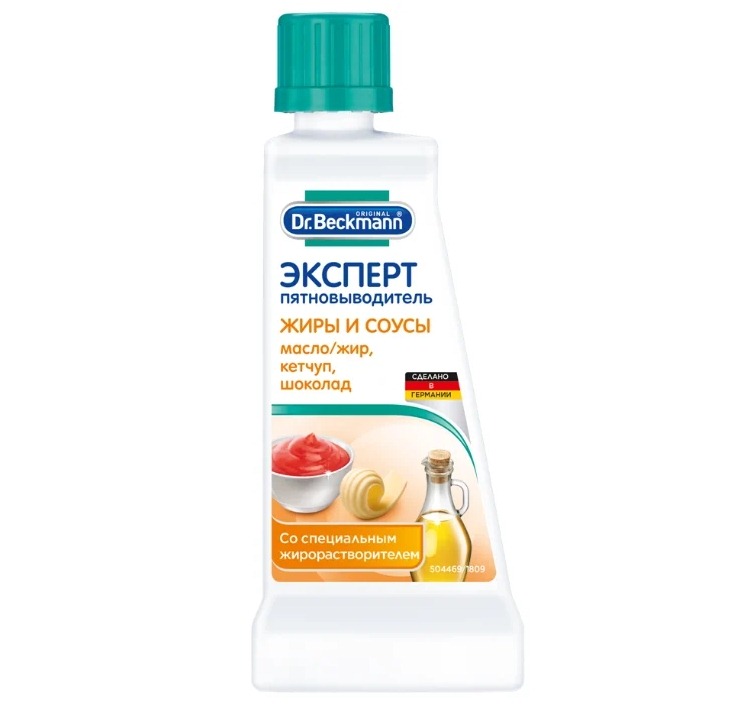
Spartan Chewing Gum Remover
The principle of operation of this tool differs from the previous one.... The effectiveness of the Remover is determined by its ability to freeze the stain without using a refrigerator.
The drug is produced in an aerosol can. In addition to wax, Chewing Gum Remover can be used to remove chewing gum and other sticky substances from fabrics.
Using a spray remover... After the wax has frozen, you can break it with your hands and brush it off the fibers. The cost of the aerosol is from 320 rubles.
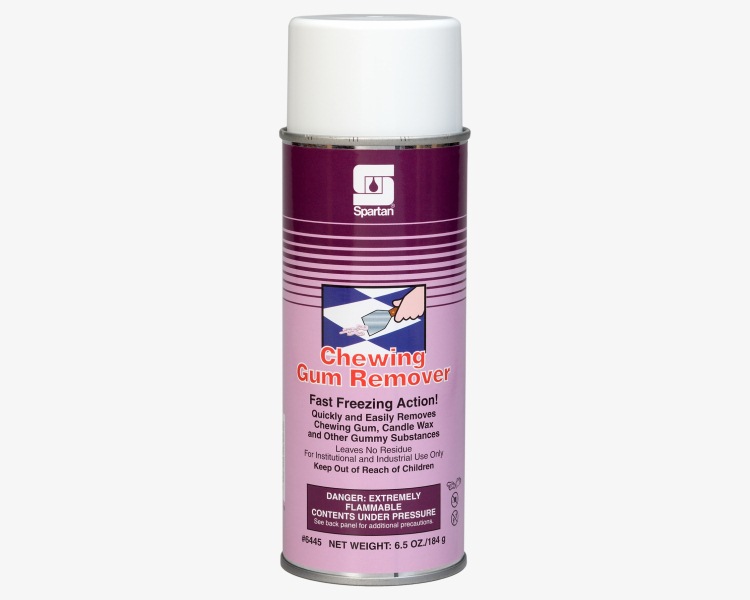
SAPUR FREEZE
SAPUR FREEZE also works on the freezing principle. After the preparation has been sprayed onto the stain, the wax must be cleaned off intensively, but without damaging the material. The price is about 700 rubles.
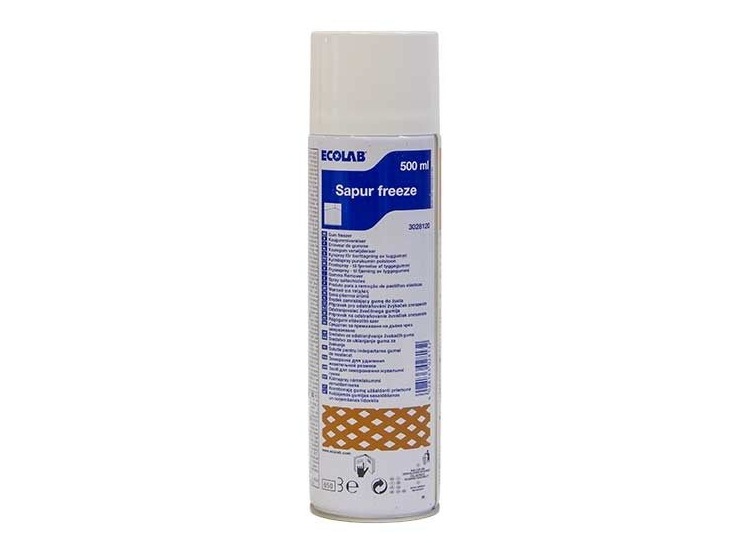
How do I clean different types of fabrics?
When removing stains of any origin, including from paraffin and depilatory wax, it is necessary to take into account the type of material and its density... It is also important to take into account the composition of the fabric when using special commercial cleaning products.
Cotton, linen
Heavy linens and cotton can be cleaned using the ironing recipe. If the material is thin, then the heating method can be used to a limited extent, using a hair dryer or steam generator for heating.
Synthetics
Artificial materials do not react well to heat, therefore, you should not use a hairdryer, let alone an iron. Temperature exposure can lead to damage to things - up to the melting of the material.
Jeans
Denim clothing often suffers from various stains. The advantage of the material is its strength. Cleaning with a dishwashing detergent will help remove stains from the fabric.
For this:
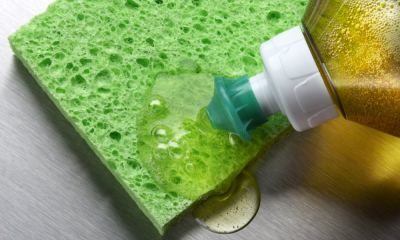 apply literally a few drops of dish gel to the stain without dampening the stain with water;
apply literally a few drops of dish gel to the stain without dampening the stain with water;- rub;
- prepare a solution for soaking using a detergent;
- soak jeans for an hour;
- wash;
- repeat the process if necessary.
Also, for denim material, a freezing method is acceptable, which makes it easy to deal with the problem. The heating method using an iron will be more effective in removing the beeswax trace.
Wool
Wool is a demanding material that must not be exposed to intense stress... To remove the stain, in this case, it is recommended to use gentle methods. These requirements are met by a recipe based on dish detergent.
The process must be completed by washing with an appropriate detergent.
Suede, velor, velvet
Velor, suede and velvet have a fleecy surface that is not easy to clean. Getting on such fabric, hot paraffin quickly spreads over the pile and reaches the base.
The iron is placed so that its sole is vertical. The section of suede covered with a cotton napkin is leaned against the iron and removed to the side... Once the paraffin has softened, it should be removed with a napkin.
The chamois can also be heated over steam to soften the wax. After that, remove with a dry napkin and clean.
Leather
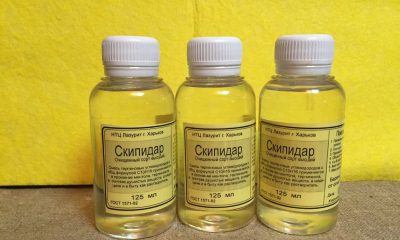 Genuine leather clothing is not sensitive to wax. A stain on the outside can be removed by holding the item in the freezer.
Genuine leather clothing is not sensitive to wax. A stain on the outside can be removed by holding the item in the freezer.
After that, the stain is broken with your hands and cleaned off. The remains of paraffin are washed off with a damp cloth.
If after treatment a trace of contamination remains, this area must be wiped with refined gasoline. or turpentine. Completes the treatment by wiping the surface dry.
Fur
One of the best ways to clean fur is by freezing it. The stain that has become fragile can be easily crumbled without damaging the look and structure of the fur.
Satin, organza, silk
Only delicate processing methods can help clean delicate fabrics... As one of the options, you can use soapy water. Another way is to use dishwashing detergent diluted with water.
What shouldn't be done and why?
Removing wax from fabrics is subject to many limitations. The type and composition of the fabric, its color and some other factors should be taken into account.
When cleaning, it is advisable to remember about a number of prohibitions:
 You cannot use the ironing recipe if the spilled wax is colored. Heat can cause the color pigment of the dye to be absorbed even more into the fabric and set, making the stain resistant.
You cannot use the ironing recipe if the spilled wax is colored. Heat can cause the color pigment of the dye to be absorbed even more into the fabric and set, making the stain resistant.- Do not use the ironing method for thin fabrics that are not resistant to heat.
- Do not try to cut off the drop with a sharp kitchen or office knife. Doing so can easily damage the material itself.
- You should also not scrape / scratch the stain too vigorously, as this can also ruin the thing - lead to cackling, thinning or breakage of the fabric.
Recommendations
Deal with wax on clothing and fabric expert advice will help:
- Before using one of the recipes, you need to carefully remove the wax blot protruding above the surface.
- Colored paraffin marks can be treated with undiluted rubbing alcohol. Do this with a napkin with blotting movements. The work must be carried out carefully so that the paint does not smudge even more.
- Fabrics with unstable dyeing deserve special attention. For them, the best option is mechanical cleaning. After removing the top layer of paraffin, talcum powder can be poured into the spot with the stain and after a time when it absorbs the pollution, it is removed. The manipulation can be repeated.
- When cleaning upholstered furniture wax, the composition of the upholstery fabric must be taken into account. It is possible to use ice cubes placed in a plastic bag as a freezing agent for oversized items.
For helpful information on how to remove wax from various surfaces, see this section.
Related videos
How to remove wax from clothes, video tips:
Conclusion
You can even remove wax from the fabric at home. There are many recipes that are simple, but effective. Special preparations can also be used, which also show a good effect, and act quickly.

